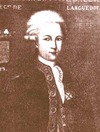GENDRON, FRANÇOIS, surgeon, donné of the Jesuits, later priest, king’s counsellor, and almoner; baptized 18 April 1618 at Voves (diocese of Chartres), son of Éloi Gendron, a farmer, and Gillette Doussineau; d. 1688 in France.
After studying surgery at Orléans for at least five years, François Gendron went to New France in 1643. He was the first doctor known to have lived in Ontario and among the North American Indians. It was in 1644–45, from Sainte-Marie-des-Hurons, that he wrote his letters, which were published in 1660 by Jean-Baptiste de Rocoles. In the Huron country, according to the testimony of Father Ragueneau, Gendron “helped the French and the Indians with great charity . . . always lived in a very edifying manner . . . without any pay, without any profit . . . for the love of God.” He spent seven years in the Huron territory as a Jesuit donné and left for France again on 23 Aug. 1650, after the destruction of the Huron country; he travelled in company with Louis Pinard and Father Pierre Pijart, and took with him an ointment for fistulas, stubborn ulcers, and cancers. Its base was a powder made from stones that he had discovered on the shores of Lake Erie and which he called “Erie Stones” (“Pierres Ériennes”). This ointment was to make his fortune in France and in 1664 was to bring him the honour of treating the queen mother, Anne of Austria, who was suffering from cancer of the breast.
Gendron was ordained on 25 May 1652, and became curate of his native parish and a doctor of the poor. His popularity increased to such an extent that he soon had to devote himself exclusively to caring for the ill, among whom were to be found persons of distinction. His treatment of the queen mother created jealousies among members of the profession, in which he was much decried. His cassock especially caused him to be suspected of charlatanism in the eyes of the envious. Nevertheless, despite his great humility and his timidity, he became famous at the court and in the whole country, in which he had travelled a great deal in order to pursue his studies and his experiments in the treatment of cancer.
When he left the court, he returned to Voves, provided with tangible evidence of the royal family’s gratitude, even though he had only been able to alleviate the queen mother’s malady. Thus on 27 Aug. 1665 he was appointed by the king commendatory abbot of Maisières in Burgundy. He used the gains which royal favour brought him for the benefit of indigent patients. Each year he sent 200 livres to Father Ragueneau in Canada.
In 1671 he took up residence in Orléans, in the house of a nephew whose son, Claude Deshaies Gendron, was to become in the 18th century the doctor of the regent, Philippe II d’Orléans. François Gendron practised until his death, which occurred on 2 April 1688. A great number of his writings have been preserved, among them a long “Memoir . . . concerning his conduct with regard to the treatment of the cancer of the late Queen Mother.”
[François Gendron], Quelques particularitez du pays des Hurons en la Nouvelle France, remarquées par le Sieur Gendron, docteur en médecine, qui a demeuré dans ce pays-là fort long-temps, éd. J.-B. de Rocoles (Troyes et Paris, 1660; réimprimé à Albany, 1868). JJ (Laverdière et Casgrain), 143. Philippe Champault, “Les Gendron ‘médecins des rois et des pauvres,’” RSCT, 2d ser., VI (1912), sect.i, 35–120. A. Dureau, Notice sur la famille Gendron (Chartres, 1868). J.-Frédéric Gendron, Nicolas Gendron et ses descendants (Montréal, s.d.). Léon Gérin, “Le Sieur Gendron,” BRH, XXXI (1925), 124. Benjamin Sulte, “Le Sieur Gendron,” BRH, XIII (1907), 182f.
Revisions based on:
Arch. Départementales d’Eure-et-Loir (Chartres, France), “Arch. en ligne: les reg. paroissiaux et d’état civil,” Voves, 18 avril 1618: www.archives28.fr/arkotheque/consult_fonds/index.php?ref_fonds=2 (consulted 19 Nov. 2015).
© 1966–2024 University of Toronto/Université Laval
Cite This Article
Gabriel Nadeau, “GENDRON, FRANÇOIS,” in Dictionary of Canadian Biography, vol. 1, University of Toronto/Université Laval, 2003–, accessed April 26, 2024, http://www.biographi.ca/en/bio/gendron_francois_1E.html.
The citation above shows the format for footnotes and endnotes according to the Chicago manual of style (16th edition). Information to be used in other citation formats:
| Permalink: | http://www.biographi.ca/en/bio/gendron_francois_1E.html |
| Author of Article: | Gabriel Nadeau |
| Title of Article: | GENDRON, FRANÇOIS |
| Publication Name: | Dictionary of Canadian Biography, vol. 1 |
| Publisher: | University of Toronto/Université Laval |
| Year of publication: | 1966 |
| Year of revision: | 2016 |
| Access Date: | April 26, 2024 |






